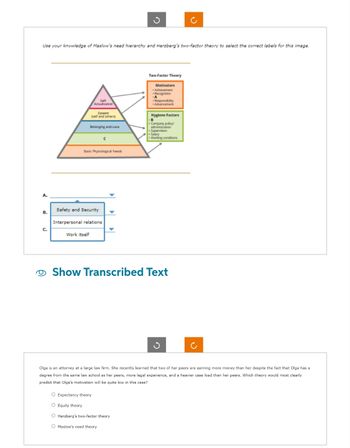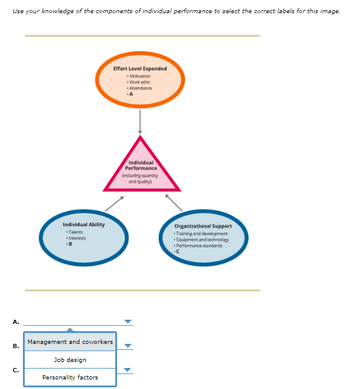Question

Transcribed Image Text:Use your knowledge of Maslow's need hierarchy and Herzberg's two-factor theory to select the correct labels for this image.
A.
B.
C.
Self-
Actualization
Esteem
(self and others)
Belonging and Love
Basic Physiological Needs
Safety and Security
Work itself
Interpersonal relations
с
Two-Factor Theory
Motivators
•Achievement
Recognition
-A
O Expectancy theory
O Equity theory
O Herzberg's two-factor theory
O Maslow's need theory
Responsibility
Advancement
Hygiene Factors
Company policy/
administration
Supervision
Salary
Working conditions
Show Transcribed Text
Olga is an attorney at a large law firm. She recently learned that two of her peers are earning more money than her despite the fact that Olga has a
degree from the same law school as her peers, more legal experience, and a heavier case load than her peers. Which theory would most clearly
predict that Olga's motivation will be quite low in this case?

Transcribed Image Text:Use your knowledge of the components of individual performance to select the correct labels for this image.
A.
B.
C.
Individual Ability
Talents
Interests
Management and coworkers
Job design
Personality factors
Effort Level Expended
Motivation
.Work ethic
Attendance
Individual
Performance
(including quantity
and quality)
Organizational Support
Training and development
*Equipment and technology
• Performance standards
Expert Solution
This question has been solved!
Explore an expertly crafted, step-by-step solution for a thorough understanding of key concepts.
This is a popular solution
Trending nowThis is a popular solution!
Step by stepSolved in 4 steps

Knowledge Booster
Similar questions
- IN REGARD TO YOUR EMPLOYEES’ MOTIVATION, WOULD YOU SAY IT REFLECTS A MORE SELF-MOTIVATED AND SELF-ENGAGING OUTLOOK, OR IS THERE A CONSTANT NEED FOR SUPERVISION AND EMPLOYEE MOTIVATION STEMS FROM REWARDS (PAY, PROMOTIONS, PRAISE)? PROVIDE EXAMPLES OF HOW SO?arrow_forwardEmployee motivation is a crucial aspect of management that involves understanding and addressing the factors that drive individuals to perform at their best. Motivated employees are more productive, engaged, and committed to achieving organizational goals. Effective managers use various techniques to inspire and encourage their teams, such as providing meaningful work, recognition, opportunities for growth and advancement, and a positive work environment. They also seek to understand the unique needs and preferences of each employee and tailor motivational strategies accordingly. By fostering a culture of motivation and empowerment, organizations can boost morale, retention rates, and overall performance. Question: How can managers identify and leverage individual motivations to create a more motivated and engaged workforce?arrow_forwardWould Blizzard need to use different motivational strategies for people who work on the creative side and the business side of the company? Why or why not? How might a company that isn't in a "fun" industry use the motivational techniques that Blizzard uses?arrow_forward
- Homonoff, T. A. (2013). Can small incentives have large effects? The impact of taxes versus bonuses on disposable bag use. Working Papers. Princeton University. Industrial Relations Section; 575. Motivation can be unconscious or conscious, extrinsic (motivated by consequences of the behavior) or intrinsic (motivated by the behavior itself), and approach or avoidance orientated. Research has shown that avoidance motivation is stronger than approach motivation. People care more about avoiding losses than they do about achieving equal-size gains. This concept is termed loss aversion. Homonoff (2013) studied grocery stores in Washington, DC, that attempted to get their customers to reuse their shopping bags by giving them a 5-cent bonus when they did so, or imposing a 5-cent tax wher they did not, both the bonus and the tax, or neither of these things. The results are shown in Figure 8.1. 47.8% 44.2% Proportion of Customers Using a Reusable Bag 15.4% 13.1% No Incentive Bonus Only Тах Only…arrow_forwardEmployees come into organizations with different needs, personalities, skills, abilities, interests,and aptitudes. They have different expectations of their employers and different views of what they think their employer has a right to expect of them. And they vary widely in what they want from their jobs. Using one of the contemporary theories of motivation, explain how it applies to this case.arrow_forwardPART 2: The motivation process is the process people go through to attempt to meet their needs. Unfortunately, the process is not always successful in meeting our needs. The motivation process can be expressed as follows: Need>>>>Motive>>>>Behavior>>>>Satisfaction (or Dissatisfaction) For example, say I am hungry (need). So, I have a drive to get something to eat (motive). I eat a ham sandwich (behavior), and that ends my hunger (satisfaction.) Or, for a dissatisfaction example, say I lose my job and am left without income (need). I am motivated to try to find another job to support my family (motive). I apply for several jobs, and get two interviews (behavior). But, I don't get offered either job. I am dissatisfied as that was not what I had hoped for. PART 2 QUESTION: Give two examples (different from the above examples) of times when you have gone through the motivation process. One example should be when the outcome of the process for you…arrow_forward
- Reflect on the differences between the culture in China and the culture in the United States and how the differences influence the types of incentives a firm might offer to motivate its employees. Using the readings, lecture, and your own scholarly research, complete an incentive analysis for China and the United States with the purpose of motivating workers. Address the following in your paper: What is the motivation culture of China and of the United States? What does a U.S. firm setting up operations in China need to know about the work culture of a Chinese employee? What incentives should an international manager offer to motivate Chinese workers of an American company?arrow_forwardBased on the various theories, people need motivators to satisfy their needs. How do these theories drive the compensation process? Should rewards be based on equity “what goes on in a person’s head”, expectancy “the probability a task can be completed” or performance?arrow_forwardCompare and contrast the following theories of the motivation process. Explain who is the author of the theory and what each one consists of. How do they look alike? What is the difference between them?*Equity Theory*Expectations theory*Reinforcement theoryarrow_forward
arrow_back_ios
arrow_forward_ios